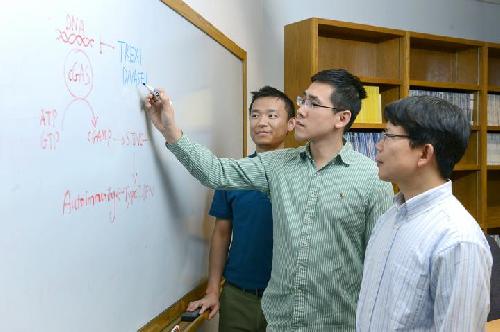DALLAS - Oct. 27, 2015 - Activating an enzyme that sounds an alarm for the body's innate immune system causes two lethal autoimmune diseases in mice, while inhibiting the same enzyme rescues them, UT Southwestern Medical Center researchers report.
The findings, published in the Oct. 20 issue of the Proceedings of the National Academy of Sciences (PNAS), could someday lead to new therapies for autoimmune diseases.
"These results suggest that inhibition of the enzyme cGAS may be an effective therapy for autoimmune diseases such as Aicardi-Goutieres Syndrome (AGS) and systemic lupus erythematosus (SLE), which are linked to the same inflammatory pathway," said senior author Dr. Zhijian "James" Chen, Professor of Molecular Biology and a Howard Hughes Medical Institute (HHMI) investigator at UT Southwestern.
 UT Southwestern researchers involved in a study that found a causal link between an immune system enzyme and autoimmune diseases included (l-r) Dr. Tuo Li, Daxing Gao, and Dr. Zhijian "James" Chen. Credit: UT Southwestern Medical Center
UT Southwestern researchers involved in a study that found a causal link between an immune system enzyme and autoimmune diseases included (l-r) Dr. Tuo Li, Daxing Gao, and Dr. Zhijian "James" Chen. Credit: UT Southwestern Medical Center
In autoimmune diseases, the immune system turns against the body instead of protecting it. AGS is a rare genetic disorder that mainly affects the brain, while SLE can affect the skin, joints, kidneys, brain, and other organs. Neither disease has a cure, only treatments to control symptoms.
Dr. Chen said cGAS is likely amenable to inhibition by small-molecule drugs and that the recent determination of the high-resolution structures of cGAS should facilitate development of such inhibitors.
The work builds on two back-to-back studies the Chen lab published in Science in late 2012 that identified cGAS as a sensor of innate immunity - the body's first line of defense against invaders. A commentary in the same issue of PNAS refers to the Chen lab's identification of that long-sought sensor of DNA in the cytoplasm, the cell's gel-like interior, as a "groundbreaking discovery."
The Science studies described a novel cell signaling pathway that starts when cGAS detects foreign DNA, such as viral DNA, and sounds the alarm. That alarm sets off an inflammatory cascade that induces antiviral molecules, including a family of secreted proteins called interferons. The same elegant system can trigger autoimmune disease when self-DNA is inappropriately present in the cytoplasm, Dr. Chen explained.
The current study in PNAS examined TREX1, a protein that digests DNA in the cell's interior. Loss-of-function mutations in the gene that codes for the TREX1 protein are linked to AGS and SLE in humans. Like humans, mice lacking TREX1 exhibit autoimmunity, inflammation, and elevated levels of interferons, the researchers report. When the researchers genetically inhibited cGAS in those mice, their symptoms disappeared.
"Even deletion of just one of the two genes for cGAS largely rescued the mice from the autoimmune disease," said Dr. Chen, who also is an investigator in the Center for the Genetics of Host Defense and holder of the George L. MacGregor Distinguished Chair in Biomedical Science.
The researchers also studied mice genetically engineered to lack a DNA-digesting enzyme called DNase-II. While the resulting inability to degrade lysosomal DNA led to lethal autoimmunity, once again cGAS inhibition rescued the mice, the researchers report.
source: UT Southwestern Medical Center